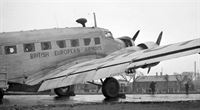Фотографии
-
Регистрационный номер: G-AHOF [6] With a typically soggy backdrop, G-AHOF sits on the ramp at Nutts Corner awaiting its return flight to Croydon. Phil Butler’s invaluable War Prizes states that this Ju 52/3mg8e arrived at the Enemy Aircraft Servicing & Storage Unit in Hamburg in January 1946, before being sold on to Short Bros in March for passenger conversion.
Самолёты на фотографии: Junkers Ju.52/3m - Германия - 1931
-
One of the ten former Luftwaffe Junkers Ju 52/3ms operated briefly by British European Airways on UK passenger services trundles along the taxiway at Belfast’s Nutts Corner airport in March 1947. Although the trimotors were popular with their crews, keeping them airworthy presented too great a challenge and they remained in service for a mere nine months. Note that the No 2 (nose-mounted) engine has been shut down to minimise wear and tear on the fragile BMW powerplants.
Самолёты на фотографии: Junkers Ju.52/3m - Германия - 1931
-
Регистрационный номер: G-AHOE [2], G-AHOF [6] A view of Nutts Corner from a port-side window of G-AHOF, with G-AHOE on the ramp below. The airport was constructed as a military airfield during 1940-41, and was declared fully operational in September 1941, becoming an important base for wartime RAF Coastal Command operations and transatlantic ferrying services.
Самолёты на фотографии: Junkers Ju.52/3m - Германия - 1931
-
Регистрационный номер: G-AHOF [6] British European Airways staff gather beside G-AHOF on the day of the inaugural non-stop London-Belfast service. The colour scheme was natural metal overall with the name of the airline in red and the BEA "speedkey" logo reversed out within a red circle on the fin. On other examples, the logo was red and not contained in a circle.
Самолёты на фотографии: Junkers Ju.52/3m - Германия - 1931
-
Регистрационный номер: G-AHOE [2], G-AHOF [6] Jupiters G-AHOF and G-AHOE are prepared for their next flights on the damp hardstanding beside the terminal at Nutts Corner. Field Air Services at Croydon managed to keep the trimotors’ BMW 132Z engines in good working order, but spares began to dry up quickly and the Ju 52/3ms were withdrawn in the summer of 1947.
Самолёты на фотографии: Junkers Ju.52/3m - Германия - 1931
-
At Belfast John was given free rein to photograph the aircraft, this study highlighting the somewhat weary trimotor’s distinctive corrugated skin and Doppelflugel (double-wing) arrangement, in which the control surfaces ran along the trailing edge of the whole wing, well separated from it and operated by a series of cranks and levers.
Самолёты на фотографии: Junkers Ju.52/3m - Германия - 1931
-
Регистрационный номер: G-AHOK, VN742 The only Ju 52/3m of BEA's fleet of ten to suffer a serious accident was G-AHOK, WNr 2998 (formerly VN742), which was damaged beyond repair in a landing accident at Glasgow-Renfrew on January 26, 1947. Written off, it was photographed by John during one of the many visits he made to Scotland at the time.
Самолёты на фотографии: Junkers Ju.52/3m - Германия - 1931
-
Регистрационный номер: G-AHOF [6] John Stroud at the controls of Ju 52/3m G-AHOF during the inaugural flight of BEA’s non-stop service from Croydon to Nutts Corner on March 20, 1947. Flying at an average speed of 125 m.p.h. (200km/h), the trimotor would usually take around 2 1/2 - 3hr to complete the journey. It would then be turned around within an hour or two for the return leg to Croydon.
Самолёты на фотографии: Junkers Ju.52/3m - Германия - 1931
-
Регистрационный номер: G-AHOF [6] Three of John’s snapshots taken aboard G-AHOF during the London-Belfast-London flight on March 20, 1947. Clockwise from top left: the view from the left-hand seat; the navigator/wireless operator at his station aft of the cockpit; Captain Derek Yapp, who served with BEA from 1945 until 1974, in the trimotor’s right-hand seat.
Самолёты на фотографии: Junkers Ju.52/3m - Германия - 1931
Статьи
- -
- A.Tincopa - Wings over Peru
- B.Turpin - Out on a Lympne (1)
- C.Gibson - Swing-wing London?
- D.Green - Biggin or Bust!
- J.Forsgren - The Imperfect 10
- J.Franzi - An Eye on the Prize /An eye for detail/
- J.Stroud - To Belfast by Jupiter! /The John Stroud Archive/
- M.Parry - Major Horace Buss
- N.Stroud - Viva Las Vegas!
- P.Davidson - Off the Beaten Track...
- P.Fiddian - The Stefan Karwowski Factor
- P.Jarrett - Lost & Found
- P.Vabre - Paper Trails in the Sky
- R.Forsyth - Defending the Reich (1)
- T.Cooper - Baptism of War








